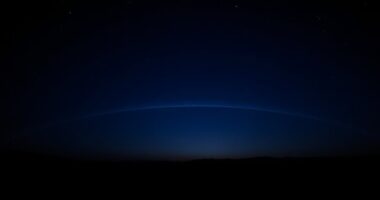To keep stars bright and neighbors happy, choose dark-sky friendly outdoor lighting by directing fixtures downward, using shields, and avoiding overly bright or blue-lit bulbs. Incorporate timers and motion sensors to minimize unnecessary illumination, and select warm color temperatures for a softer glow. Collaborate with your community to establish policies and maintain your system through regular checks. Keep these tips in mind, and you’ll create a safer, more peaceful night environment that benefits everyone.
Key Takeaways
- Use shielded fixtures directed downward to reduce skyglow and prevent light trespass into neighbors’ properties.
- Choose warm-colored, low-intensity lights (2700K–3000K, 300–700 lumens) for softer illumination.
- Install timers and motion sensors to activate lights only when needed, conserving energy and minimizing disruption.
- Regularly maintain fixtures by cleaning and adjusting to ensure proper shielding and correct light direction.
- Collaborate with community policies to enforce responsible outdoor lighting and promote dark-sky friendly practices.
Understanding Light Pollution and Its Impact
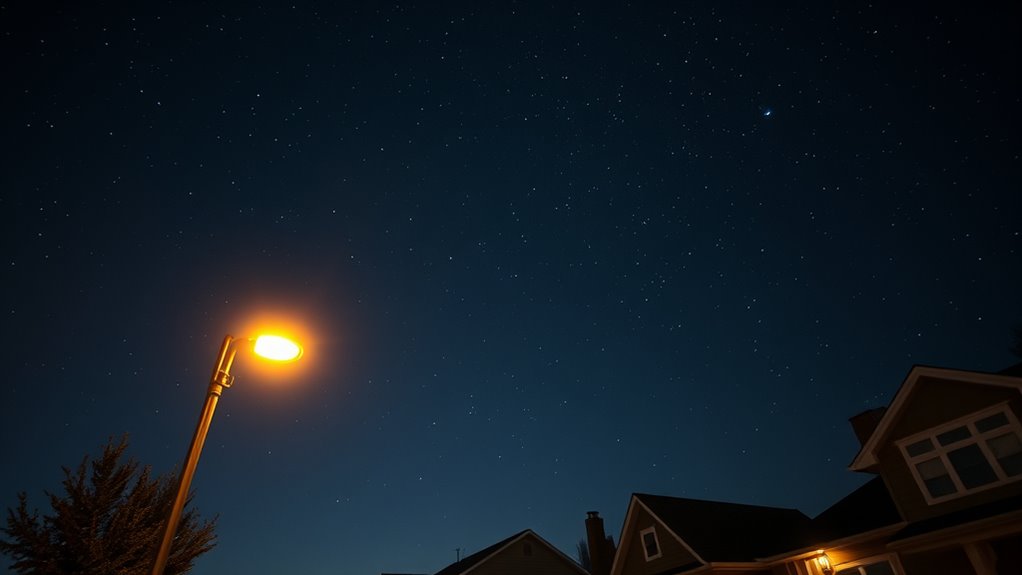
Light pollution occurs when excessive or misdirected artificial light brightens the night sky, making it difficult to see stars and planets. Urban glow, caused by streetlights, billboards, and building illumination, contributes notably to skyglow effects. This glow creates a luminous haze that spills into the atmosphere, drowning out celestial objects. When you’re in a brightly lit city, the sky’s darkness diminishes, hiding the beauty of constellations and planets. Light pollution doesn’t just obscure views; it also disrupts ecosystems and affects human health by disturbing natural circadian rhythms. Understanding how urban glow amplifies skyglow effects helps you recognize the importance of responsible lighting. Reducing unnecessary brightness benefits everyone, restoring the night sky’s natural beauty and conserving energy. Implementing Dark-Sky Friendly Lighting practices can significantly mitigate these effects.
The Principles of Dark-Sky Friendly Lighting

To effectively reduce light pollution, implementing dark-sky friendly lighting principles is key. You should focus on controlling spectral quality to minimize blue light emissions, which are most harmful to both stars and wildlife. Shield your fixtures to prevent light trespass into neighboring properties, ensuring light stays where it’s needed. Use lower-intensity lights that still meet safety needs without over-illumination. Incorporating AI-powered lighting controls can optimize illumination levels and further reduce unnecessary light emissions.
Selecting Proper Fixtures for Outdoor Spaces

Choosing the right fixtures is essential for ensuring outdoor lighting remains effective while minimizing light pollution. Proper fixture placement helps illuminate your space without spilling light into the sky or neighboring properties. Use fixtures that direct light downward, reducing glare and preventing unnecessary light trespass. Select fixtures with shields or louvers to control light distribution and keep illumination focused where it’s needed. Avoid overly bright or unshielded fixtures that cause glare or contribute to skyglow. When installing, consider the height and angle to optimize coverage and safety. Clear pathways, entrances, and key features without overlighting. Thoughtfully choosing fixtures and arranging them carefully will help you achieve a well-lit outdoor space that’s both functional and friendly to the night sky. Additionally, using dark-sky friendly lighting fixtures can significantly reduce light pollution and promote a more natural night environment.
Directing Light Where It’s Needed Most

Proper fixture placement and shielding are just the starting points; directing light precisely where it’s needed makes a significant difference. To reduce light trespass and avoid illuminating unwanted areas, focus on angling fixtures downward and away from neighbors. Proper fixture placement ensures light shines only on your intended spaces, preventing glare and light spill. Consider using shields or louvers to further control light direction. Additionally, selecting fixtures with a warm color palette can help create a cozy, inviting atmosphere while minimizing harsh glare.
Choosing the Right Brightness Levels
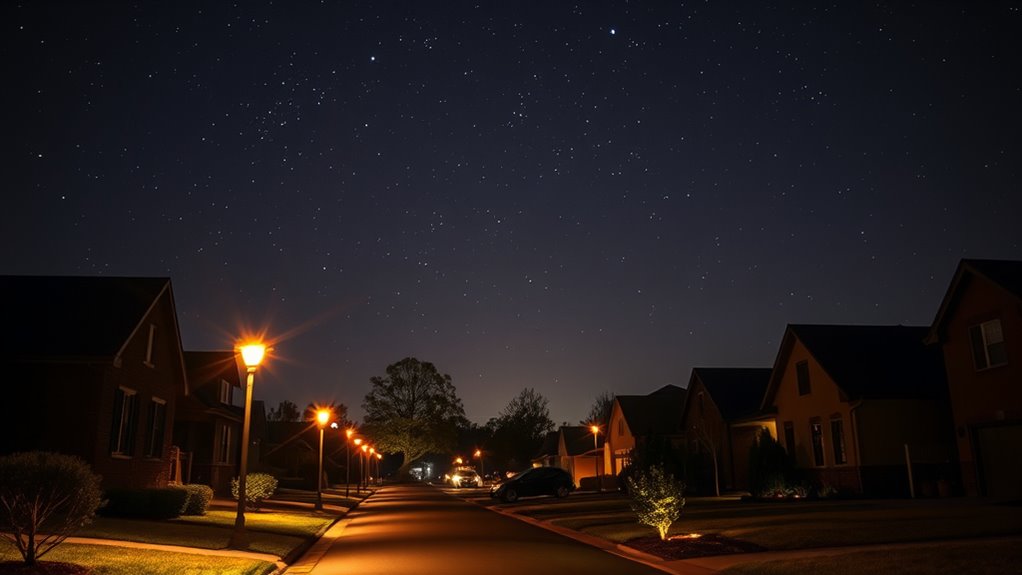
Choosing the right brightness levels guarantees your outdoor lighting is effective without contributing to light pollution. You should aim for an ideal lumens range that illuminates safely while minimizing excess light. Adjusting brightness based on safety needs helps you create a well-lit, dark-sky friendly environment. For instance, selecting the appropriate light fixtures can further reduce unwanted glare and skyglow.
Optimal Lumens Range
Selecting the right brightness level for outdoor lighting is essential to minimize light pollution while guaranteeing safety and visibility. The ideal lumens range depends on your space’s purpose and fixture calibration. Generally, for residential areas, 300 to 700 lumens provide sufficient brightness without excess glow. For larger yards or commercial spaces, 700 to 1,200 lumens may be necessary. Proper lumen calibration ensures you avoid over-illuminating, saving energy and reducing skyglow. Additionally, choosing fixtures with high durability guarantees they withstand weather conditions, maintaining consistent lumen output over time. When selecting lighting, consider dark-sky friendly designs that are specifically engineered to reduce skyglow and light trespass, enhancing night sky visibility for everyone.
Adjusting for Safety
Ensuring safety through appropriate lighting levels requires careful adjustment of brightness to prevent both under- and over-illumination. Too bright, and you risk glare reduction issues, making it uncomfortable or unsafe for pedestrians and drivers. Too dim, and safety is compromised, increasing accident risks. Choose fixtures with durable designs that withstand weather and vandalism, guaranteeing consistent illumination. Use the following guide to select the right brightness:
| Situation | Recommended Lumens | Notes |
|---|---|---|
| Pathways & Sidewalks | 100–300 | Minimize glare, enhance safety |
| Parking Lots | 200–400 | Balance visibility and light pollution |
| Entrances & Exits | 300–600 | Bright enough for safety, durable fixtures |
Adjusting brightness accordingly ensures safety while maintaining dark-sky friendliness. Additionally, selecting fixtures with proper shielding helps direct light downward, reducing light pollution and preserving night sky visibility.
Using Warm Color Temperatures for a Softer Glow
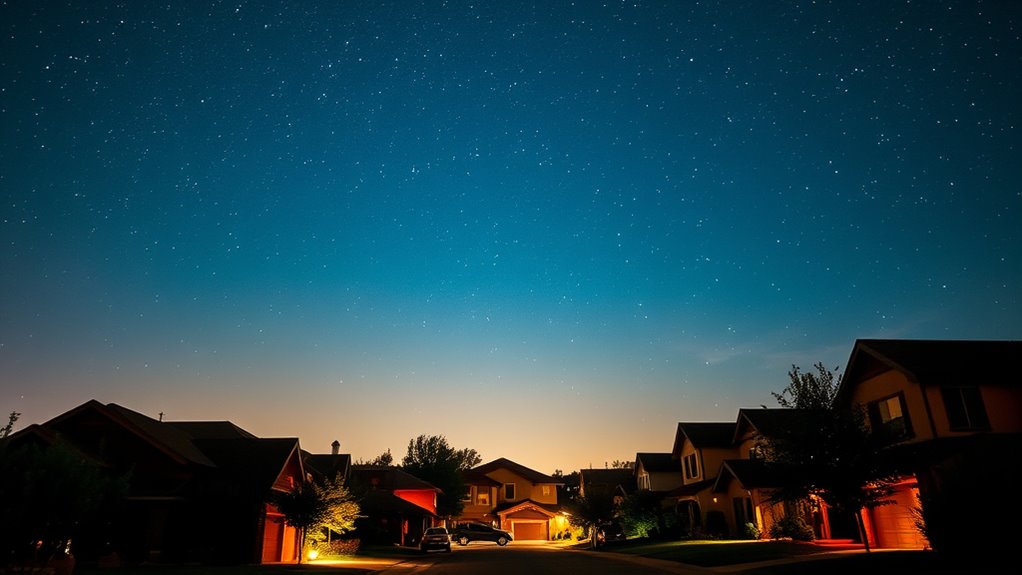
Because harsh, cool-toned lighting can disrupt the natural night environment, using warm color temperatures creates a softer, more inviting glow. Warm lighting, typically around 2700K to 3000K, reduces glare and blends better with the night sky. This softer glow not only minimizes light pollution but also enhances the natural beauty of stars and surrounding landscapes. When choosing fixtures, prioritize those with a lower color temperature to keep the environment welcoming. Additionally, warm lighting helps neighbors feel comfortable and reduces unnecessary light spillage. Using color temperature as a guide ensures you select the most appropriate lighting for your outdoor spaces. – Creates a cozy, inviting atmosphere for outdoor spaces – Minimizes glare that can disturb wildlife and neighbors – Preserves the natural aesthetics by reducing harsh, blue-toned light
Implementing Timers and Motion Sensors
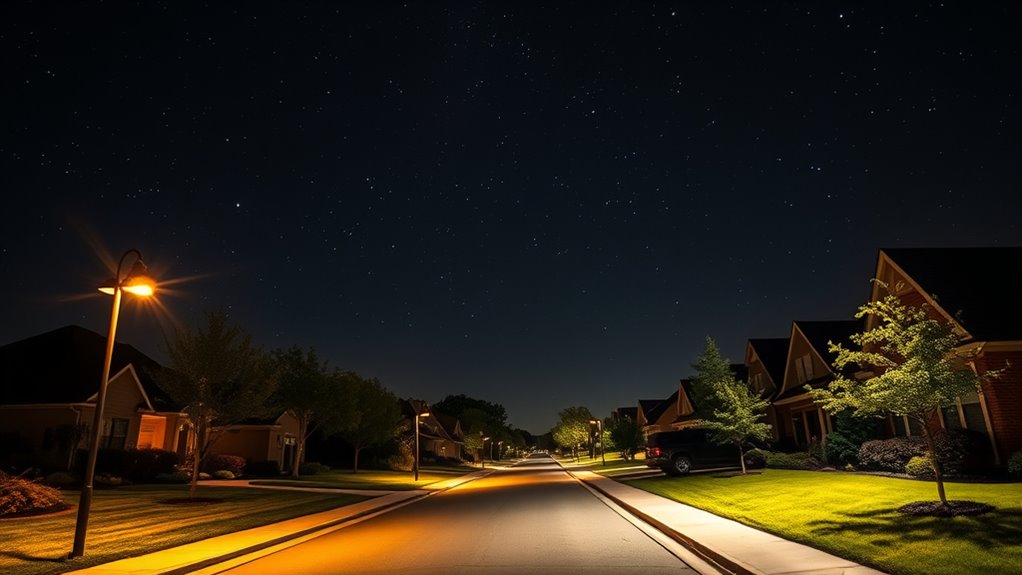
Installing timers and motion sensors gives you better control over your outdoor lighting, preventing unnecessary illumination. These tools help you conserve energy by turning lights off when they’re not needed. By using them, you enhance your lighting system’s efficiency and reduce light pollution effectively. Additionally, integrating automatic controls ensures your lighting remains environmentally friendly and cost-effective.
Enhancing Light Control
To effectively control outdoor lighting and reduce light pollution, incorporating timers and motion sensors is essential. These tools help you turn lights off when not needed, minimizing glare reduction and wasted energy. Proper fixture placement combined with sensors ensures light is directed downward, preventing unnecessary skyglow and neighbor disturbance. Additionally, understanding Relationship – Personality Test can help foster a safe and respectful environment for neighbors by promoting awareness and empathy.
Conserving Energy Effectively
Using timers and motion sensors is one of the most effective ways to conserve energy with your outdoor lighting. Timers automatically turn lights off during daylight hours or late at night, reducing unnecessary energy use. Motion sensors activate lights only when movement is detected, preventing waste when areas are unoccupied. By integrating these devices with solar panels, you can maximize energy efficiency and reduce reliance on grid power. Urban planning that promotes strategic placement of outdoor lights further minimizes excess illumination, supporting dark-sky initiatives. Installing timers and motion sensors not only saves energy but also prolongs the lifespan of your lighting fixtures. These measures help create a more sustainable outdoor environment while keeping your neighborhood well-lit without excessive energy consumption.
Coordinating Community Lighting Policies
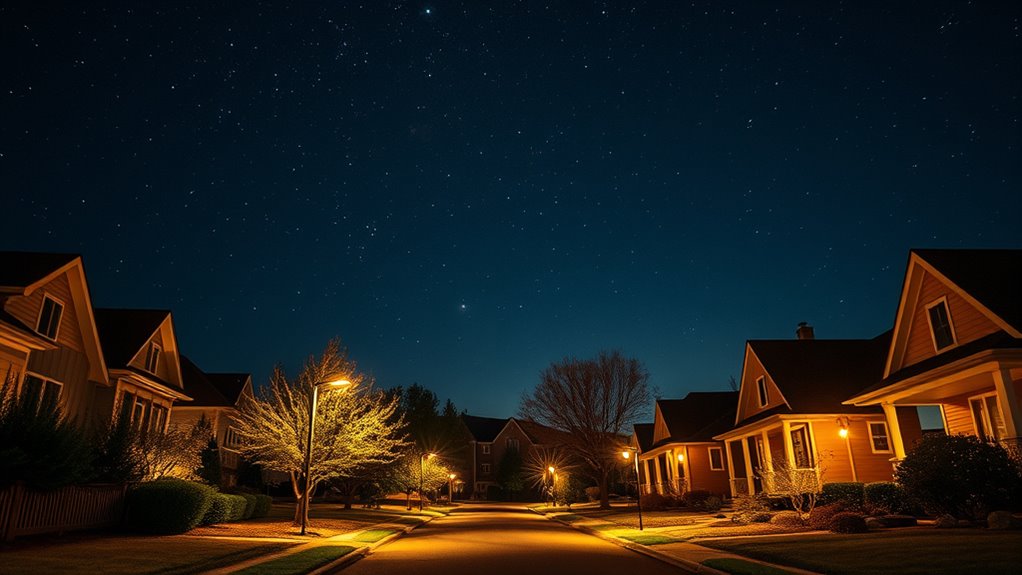
Effective coordination of community lighting policies is essential for minimizing light pollution and ensuring consistent dark-sky standards across neighborhoods. When you promote community engagement, residents become active participants in protecting night skies, making policy enforcement more effective. Collaborate with local authorities, neighborhood groups, and businesses to create clear, enforceable guidelines that everyone understands. Regular communication helps keep residents informed and motivated to follow lighting ordinances. By working together, you can establish shared goals and maintain a cohesive approach to outdoor lighting.
Community collaboration and clear guidelines are key to effective outdoor lighting policies.
- Organize community meetings to gather feedback and build support
- Develop clear, enforceable regulations that address specific needs
- Recognize and celebrate neighborhoods that excel in dark-sky compliance
Tips for Maintaining Your Dark-Sky Friendly System

Maintaining your dark-sky friendly lighting system requires regular attention and proactive care. Check your fixtures periodically to guarantee they remain properly shielded, directing light downward and minimizing light spill. This not only preserves the night sky but also supports wildlife protection by reducing disruption to nocturnal animals. Clean fixtures regularly to prevent dirt buildup that can diminish light effectiveness and cause unnecessary brightness. Adjust timers and dimmers seasonally to match natural darkness levels, enhancing aesthetic considerations while conserving energy. Be mindful of surrounding landscape and architectural features to prevent glare and maintain visual harmony. Consistent maintenance assures your system continues to keep stars bright, neighbors happy, and the environment protected. Staying vigilant will help your outdoor lighting stay effective and environmentally friendly over time.
Frequently Asked Questions
How Can I Measure the Light Pollution Levels Around My Property?
To measure light pollution levels around your property, you can perform a sky brightness assessment using a light meter or smartphone app designed for this purpose. These tools help you conduct a light pollution measurement by recording the sky’s brightness at night. Regular assessments allow you to track changes over time, identify sources of excess light, and take steps to reduce light pollution, creating a darker, healthier environment for stargazing.
Are There Specific Regulations or Certifications for Dark-Sky Friendly Lighting?
You ask about regulations and certifications for dark-sky friendly lighting. Many areas follow strict lighting standards to minimize pollution, aiming to reduce glare and skyglow. Certification programs like the International Dark-Sky Association’s fixtures and local ordinances help you identify compliant lighting solutions. By choosing products with these certifications, you guarantee your outdoor lighting supports star visibility, respects neighbors, and aligns with community and environmental standards.
What Are Cost-Effective Options for Retrofitting Existing Outdoor Lighting?
You can save money on retrofitting outdoor lighting by installing solar sensors and motion detectors. Solar sensors allow your lights to run efficiently using sunlight, reducing energy costs. Motion detectors ensure lights turn on only when needed, minimizing waste. These options are cost-effective, easy to implement, and help improve light direction, reducing skyglow and light pollution. Upgrading with these features benefits your budget and helps keep stars bright.
How Can I Educate Neighbors About the Benefits of Dark-Sky Lighting?
You can start by hosting community engagement events or informational sessions to share the benefits of dark-sky lighting. Use educational outreach materials, like flyers or social media posts, to highlight how it improves night sky visibility and reduces light pollution. Encourage neighbors to ask questions and share their concerns, fostering a collaborative approach. Building awareness through positive conversations helps neighbors understand that dark-sky lighting benefits everyone, making your community brighter and more harmonious.
What Are the Long-Term Maintenance Considerations for Dark-Sky Friendly Fixtures?
Did you know that poorly maintained fixtures can decrease energy efficiency by up to 20%? To guarantee longevity, you should regularly inspect your dark-sky friendly fixtures for issues like corrosion or damage. Consider fixture durability when selecting products, and plan for easy bulb replacement to avoid costly repairs. Routine maintenance not only prolongs fixture life but also keeps your outdoor lighting effective and in harmony with the night sky.
Conclusion
By adopting dark-sky friendly lighting, you’re like a guardian of the night’s natural beauty, ensuring stars stay bright and your neighbors enjoy peaceful evenings. When you choose proper fixtures, direct light thoughtfully, and use warm tones, you help preserve the night sky for everyone. Regular maintenance and community efforts make it easier to keep your outdoor lighting effective and eco-friendly. Together, you create a harmonious balance between illumination and the starry sky, like a gentle dance under the night.


